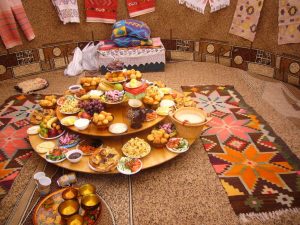




One of the most distinctive symbols of Kazakh culture is the traditional round dastarkhan (table) on low legs, placed exactly in the center of the yurt. Its shape in the form of a circle – represented by the sun, the source of life – symbolized the unity of the family, the family, the people. Dastarkhan has a sacral meaning: one of the constant prohibitions is disrespecting it; eating together behind the dastarhan means rapprochement, building friendly, amicable relations [4, p. 156]. In the tradition of Kazakhs the dastarkhan together with the hearth, the threshold and the shanyraq must not be desecrated, i.e. it is impossible to refuse the offered food – “dastarkhanan biik emes” (“not higher than dastarhan”), to step over the dastarhan etc.There were rules for seating around the dastarhan: the degree of kinship, age and social status were taken into account. The ethical rules of the dastarhan were strictly observed: One should not eat in front of elders, make noise at the table, etc. The importance of dastarhan is especially evident in the traditional benevolent wishes: “Dastarkhanıñ bai bolsyn, qazan – oshağiñ may bolsyn, tört tüligin say bolsyn, köñilin tolyp zhai bolsyn!”, which means wishes for a rich dastarhan, abundance and happiness.
In the ritual tradition of dastarhan is the sacred place of appeal to the spirits, the Almighty, “feeding” aruakh (spirits of the deceased):preferably more people should eat from the dastarkhan of the ritual (memorial) meal.


